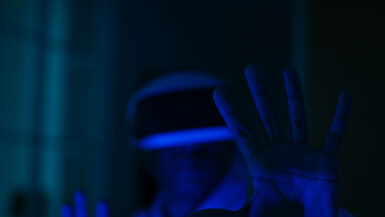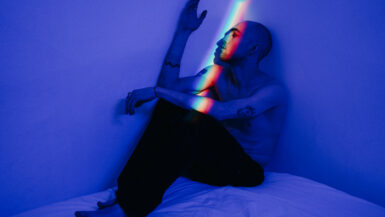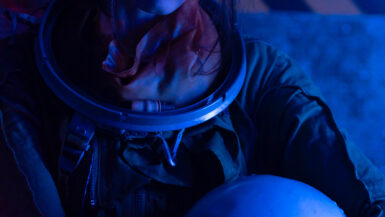In today’s fast-paced, technology-driven world, exposure to blue light from electronic devices has become an inevitable part of our daily lives. The effects of this blue light on our sleep patterns and overall productivity have raised concerns among researchers and health professionals alike. In this article, we delve into the potential link between blue light exposure and sleep apnea, a prevalent sleep disorder affecting millions of individuals worldwide. Through an in-depth analysis of scientific studies and expert opinions, we aim to shed light on the mechanisms that connect blue light exposure to sleep apnea and provide guidance on how to mitigate its impact on our well-being and efficiency.
Effective Ways to Reduce Blue Light Exposure
As we have established the potential link between blue light exposure and sleep apnea, it becomes essential to explore the various methods to minimize the impact of blue light on our daily lives. In this section, we will discuss practical and effective strategies to reduce exposure to blue light, ultimately promoting better sleep quality and overall health.
Establish a Technology-Free Bedroom
One of the most effective ways to reduce blue light exposure is to create a technology-free zone in the bedroom. By keeping electronic devices, such as smartphones, tablets, and laptops, out of the bedroom, you can significantly reduce your nighttime exposure to blue light. This practice not only helps improve sleep quality but also fosters a more relaxing and peaceful environment conducive to rest.
Invest in Blue Light Blocking Glasses
Blue light blocking glasses are designed to filter out the harmful blue light emitted by electronic devices. Wearing these glasses, especially during the evening hours, can help lower the impact of blue light on your sleep patterns. They can be especially beneficial for individuals who have a history of chronic fatigue syndrome or sleep apnea. For more information on how blue light affects chronic fatigue syndrome, check out our article on Blue Light Exposure and Its Impact on Chronic Fatigue Syndrome.
Use Blue Light Filtering Apps and Software
Many apps and software programs are designed to reduce blue light emissions from electronic devices. These applications adjust the color temperature of your device’s display to emit warmer colors, which are less disruptive to sleep. Examples of such apps include f.lux for desktop computers and Night Shift for Apple devices.
Adopt a Consistent Sleep Schedule
Maintaining a regular sleep schedule is crucial for overall sleep health. Going to bed and waking up at the same time every day can help regulate your body’s internal clock. This consistency aids in falling asleep faster and experiencing a more restful night’s sleep, reducing the negative effects of blue light exposure on sleep apnea.
Expose Yourself to Natural Light During the Day
Lastly, increasing your exposure to natural sunlight during the daytime can help counterbalance the effects of blue light exposure in the evening. Natural light exposure helps regulate your circadian rhythm, ensuring that your body is in sync with the day-night cycle. By incorporating outdoor activities or working near a window during the day, you can improve your sleep quality and reduce the impact of blue light on your sleep patterns.
Incorporating these strategies into your daily routine can help minimize the adverse effects of blue light exposure on sleep apnea and overall health. By taking proactive steps to reduce blue light exposure, you can improve your sleep quality, boost productivity, and enhance your overall well-being.
How Blue Light Affects Our Sleep Cycle
As we delve deeper into the connection between blue light exposure and sleep apnea, it is crucial to understand the underlying mechanisms that link blue light to our sleep cycle. This section will explore the science behind how blue light influences our circadian rhythm, sleep hormones, and overall sleep quality.
The Role of Circadian Rhythm in Sleep
Our circadian rhythm, also known as our internal body clock, is a 24-hour cycle that regulates various physiological processes, including sleep. Our exposure to light, both natural and artificial, plays a crucial role in maintaining this internal clock. Blue light, in particular, has a significant impact on our circadian rhythm, as it suppresses the production of melatonin, the sleep hormone, and promotes wakefulness.
Blue Light and Melatonin Suppression
Melatonin is a hormone produced by the pineal gland that helps regulate our sleep-wake cycle. The production of melatonin increases in the evening as natural light diminishes, signaling to our bodies that it is time to sleep. However, exposure to blue light from electronic devices can disrupt this process by inhibiting melatonin production, making it more challenging to fall asleep and stay asleep throughout the night. This disruption to our sleep cycle may contribute to the development or exacerbation of sleep apnea.
Blue Light’s Impact on Sleep Quality
Apart from melatonin suppression, blue light exposure can also affect the quality of our sleep. Research has shown that exposure to blue light before bedtime can lead to a decrease in rapid eye movement (REM) sleep, which is essential for memory consolidation and emotional regulation. A reduction in REM sleep may result in grogginess, impaired cognitive function, and mood disturbances the following day.
Individual Variability in Blue Light Sensitivity
It is essential to note that the impact of blue light on sleep can vary between individuals. Factors such as age, genetics, and lifestyle habits can influence one’s sensitivity to blue light exposure. For example, older adults may be more susceptible to the effects of blue light on sleep, as the natural lens of the eye becomes less effective at filtering out blue light with age. Similarly, individuals with a genetic predisposition to sleep disorders may be more vulnerable to the impact of blue light on their sleep cycle.
Taking into account the various ways blue light can affect our sleep cycle, it becomes evident that minimizing blue light exposure, especially before bedtime, is crucial for maintaining healthy sleep patterns. By understanding the science behind blue light’s impact on our sleep cycle, we can make informed decisions to promote better sleep quality and reduce the risk of sleep apnea.
Improving Sleep Quality for Better Productivity
Finding ways to improve sleep quality is essential for enhancing productivity, as poor sleep can lead to reduced cognitive function, decreased energy levels, and impaired decision-making abilities. By addressing the impact of blue light on sleep apnea, we can take steps to minimize its negative effects and optimize our sleep for better performance during waking hours. In this section, we will discuss various strategies to enhance sleep quality and mitigate the impact of blue light on sleep apnea, ultimately paving the way for improved productivity and well-being.
Create a Sleep-Friendly Environment
Designing a comfortable, serene, and relaxing bedroom environment is crucial for promoting better sleep quality. Factors such as room temperature, lighting, and noise levels can significantly affect the quality of sleep. Aim for a cool, dark, and quiet space by using blackout curtains, adjusting the thermostat, and utilizing white noise machines or earplugs as needed.
Practice Good Sleep Hygiene
Maintaining a consistent pre-sleep routine can help signal to your body that it’s time to wind down and prepare for sleep. Incorporate relaxing activities such as reading, taking a warm bath, or practicing mindfulness meditation into your nightly routine. Additionally, avoid stimulating activities or substances such as caffeine, nicotine, and alcohol close to bedtime, as they can interfere with your ability to fall asleep.
Engage in Regular Physical Activity
Regular exercise has been shown to improve sleep quality and reduce the risk of sleep apnea. Aim for at least 150 minutes of moderate-intensity aerobic activity, such as brisk walking or swimming, each week. However, it’s essential to avoid vigorous exercise close to bedtime, as it can have a stimulating effect and make it more challenging to fall asleep.
Manage Stress and Anxiety
High levels of stress and anxiety can negatively impact sleep quality and exacerbate sleep apnea. Consider incorporating stress-reduction techniques such as deep breathing exercises, progressive muscle relaxation, or cognitive-behavioral therapy into your daily routine. By effectively managing stress and anxiety, you can create a more conducive environment for restful sleep and improved productivity.
Seek Professional Help if Necessary
If you continue to struggle with sleep apnea or poor sleep quality despite implementing the strategies discussed above, it may be necessary to consult with a healthcare professional. A sleep specialist can evaluate your symptoms, recommend appropriate treatment options, or refer you to a sleep clinic for further evaluation if needed.
By taking proactive steps to improve sleep quality and address the impact of blue light on sleep apnea, we can set the stage for enhanced productivity and overall well-being. Prioritizing healthy sleep habits and minimizing blue light exposure can have a significant positive impact on both our personal and professional lives, ultimately leading to a more balanced and fulfilling lifestyle.
Understanding Blue Light and Its Sources
Before delving into the relationship between blue light and sleep apnea, it is essential to comprehend what blue light is and where it comes from. This subsection will provide an overview of the sources of blue light, both natural and artificial, and explain why it has become such a prevalent concern in modern society.
The Science Behind Blue Light
Blue light is a part of the visible light spectrum, characterized by its short wavelengths and high energy levels. It lies within the range of 380 to 500 nanometers and is known to have both beneficial and adverse effects on our health. On one hand, blue light exposure during daylight hours can improve alertness, mood, and cognitive function. On the other hand, excessive exposure to blue light, particularly in the evening, can disrupt our sleep patterns and negatively impact overall well-being.
Natural Sources of Blue Light: The Sun
The primary source of blue light is the sun, which emits a wide range of light wavelengths, including blue light. In fact, the sky appears blue during the day because the Earth’s atmosphere scatters the sun’s shorter-wavelength blue light more effectively than the longer-wavelength red light. This natural exposure to blue light during daytime hours plays a vital role in maintaining our circadian rhythm and promoting wakefulness.
Artificial Sources of Blue Light: Electronic Devices and LED Lighting
In recent years, the widespread use of electronic devices such as smartphones, tablets, laptops, and televisions has significantly increased our exposure to blue light. These devices emit high levels of blue light, which can interfere with our sleep patterns when used during nighttime hours. Additionally, energy-efficient LED lighting, which is commonly used in homes and offices, also emits blue light, further contributing to increased exposure.
Why Blue Light Exposure Has Become a Concern
As our reliance on technology continues to grow, so does our exposure to artificial sources of blue light. This increased exposure, especially during the evening, has raised concerns among researchers and health professionals about the potential impact of blue light on sleep and overall health. Prolonged exposure to blue light during nighttime hours can disrupt our circadian rhythm, suppress melatonin production, and lead to sleep disturbances, including sleep apnea.
Recognizing the various sources of blue light and understanding its potential effects on our health is crucial in addressing the link between blue light and sleep apnea. By being mindful of our exposure to blue light, we can make informed decisions to protect our sleep patterns and promote overall well-being.
The Connection between Blue Light Exposure and Sleep Apnea
As we explore the relationship between blue light exposure and sleep apnea, it is essential to understand the potential mechanisms that link the two phenomena. In this subsection, we will delve into the scientific studies and expert opinions that shed light on how excessive exposure to blue light may contribute to the development or exacerbation of sleep apnea, a widespread sleep disorder affecting millions of individuals worldwide.
The Role of Melatonin in Sleep Apnea
Research has shown that melatonin, a hormone responsible for regulating our sleep-wake cycle, plays a crucial role in sleep apnea. Melatonin production increases during the evening, signaling our body that it is time to rest. However, exposure to blue light can suppress melatonin production, leading to sleep disturbances and, in some cases, sleep apnea. Understanding the connection between blue light exposure and melatonin suppression is key to addressing the link between blue light and sleep apnea.
Effects of Blue Light on Circadian Rhythm Disruption
Circadian rhythm disruption is another factor that may contribute to the relationship between blue light exposure and sleep apnea. Studies have shown that exposure to blue light, particularly during the evening, can disrupt our internal body clock, leading to sleep disturbances and difficulties in falling asleep. This disruption in the circadian rhythm can, in turn, exacerbate sleep apnea symptoms, as individuals struggle to maintain regular sleep patterns.
Impact of Blue Light on Sleep Quality and Apnea Severity
In addition to melatonin suppression and circadian rhythm disruption, blue light exposure has also been linked to a decrease in sleep quality, which can further aggravate sleep apnea symptoms. Exposure to blue light before bedtime has been shown to reduce rapid eye movement (REM) sleep, a critical phase of sleep necessary for memory consolidation and emotional regulation. Poor sleep quality, in turn, can increase the severity of sleep apnea, leading to more significant health implications.
Individual Susceptibility to Blue Light Exposure
It is important to note that the connection between blue light exposure and sleep apnea may vary from one individual to another. Factors such as age, genetics, and lifestyle habits can influence an individual’s susceptibility to the effects of blue light on sleep. For instance, older adults may be more vulnerable to blue light exposure, as the natural lens of the eye becomes less effective at filtering out blue light with age. Similarly, those with a genetic predisposition to sleep disorders may be more susceptible to the impact of blue light on their sleep patterns.
By examining the various factors that connect blue light exposure to sleep apnea, we can better understand the potential risks associated with excessive blue light exposure and take appropriate steps to mitigate its impact on our sleep and overall health. Recognizing the relationship between blue light and sleep apnea is crucial for developing effective strategies to promote better sleep quality and reduce the prevalence of this widespread sleep disorder.





Leave a reply